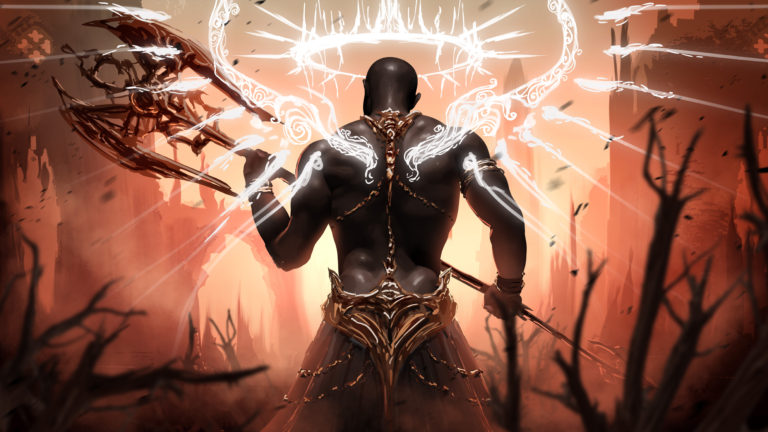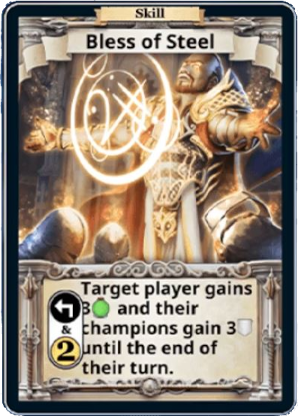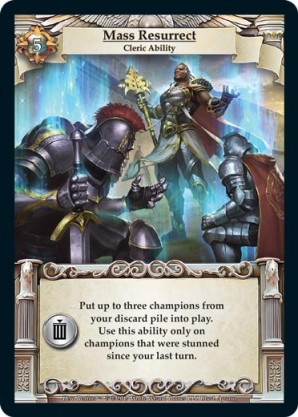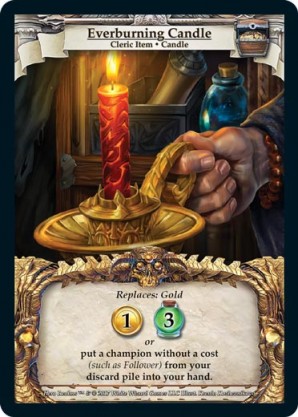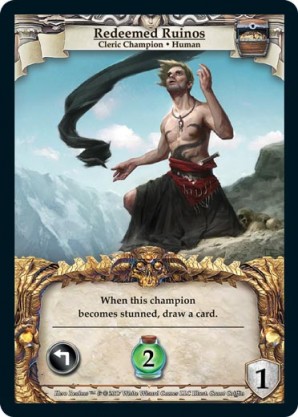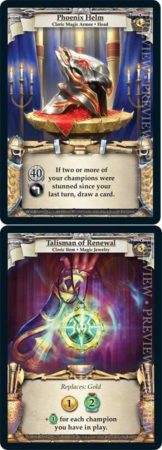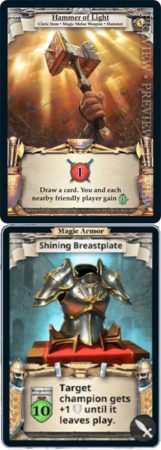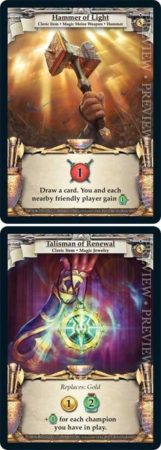The Life of a Cleric (Part 2) – Embracing the Power of the Light
In the First Part of this series, I covered the starting Cleric Deck and Upgrade Options while leveling. In part two, we’ll discuss a few of my favorite character builds, deck-building strategies, and the various matchup considerations.
“The Great Wall of Thandar!”
The Character Build
The Great Wall Cleric is based around the Cleric Abilities Bless of Steel. Typically, this playstyle is designed to keep control of the board through mass amounts of buffed champions. Bless of Steel takes full advantage of flooding small to medium defense champions on the board because its “+3 Defense Bonus” effectively applies to every champion making it much more difficult for your opponent to clear your board.
This build performs best when there is constant presence of multiple champions on the board, so usually Mass Resurrect is the best option to ensure that advantage. There is definitely room to argue that Divine Ressurection is better, due to the lack of healing in Steel cleric and for the extra draw. Both are completely viable, but need to be paired with different upgrades.
In my opinion, Everburning Candle and Redeemed Ruinos are the best two options when playing this style. Everburning Candle allows you to recycle your followers, helping to build your wall at the right time as well as giving you more opportunities for Phoenix Helm procs. Redeemed Ruinos helps keep my health above that 40 Health requirement and the style of play pretty much guarantees that I’m going to be drawing an extra card most turns. This turns into a valuable advantage over time. I choose to pair Talisman with Helm because you need that extra healing to stay above the 40-health threshold. Also, the healing from Talisman takes advantage of how many champions this deck tends to run, increasing it’s healing potential. This build works very well with Mass Resurrect. Once you’ve purchased 4-5 champions, inevitably, 2-3 of them will land on the board at the same time. After they are stunned, use Mass Resurrect only when you have 2-3 more champions in hand to build a wall of 5 or more champions AND you can Bless of Steel. This creates your Great Wall of Thandar. Continue buying champions and hold up that wall, overpowering your opponent. This is probably the most “aggressive” version of cleric that you’ll find.
As I mentioned earlier, you can run Divine Resurrect instead of Mass Resurrect. If you do this, I recommend running Brightstar shield instead of Redeemed Ruinos. This version is less about the Mass wall and more about protecting 1 or 2 powerful non-guard champions behind your followers or other guards. This build also runs Shining Breastplate. The goal here is to buy a single champion that can be abused early, and then protect it behind followers. You typically want to stack your Breastplate buffs on the protected non-guard champion since your followers or other guards are more likely to be stunned and lose the buff. This strategy is countered by several Guild (Blue) market cards, or a few upgrades from other classes. I don’t find this build to be quite as reliable as the previous one, but it can be a lot of fun to pilot. I like to pair Hammer with this build since I find that Hammer is more versatile than Talisman if you don’t need the healing. Hammer combos well with Varrick, and several Guild (blue) cards. If the market is devoid of any smaller champions that you will typically want to combo with, ramping up your deck quickly with Guild cards can lead to a great damage and economy that can then lead to powerful turns where you can place a card on top of your deck, then draw with hammer or your Brightstar Shield.
Buying from the Market
Champions are what drive this style of play, especially cheaper ones (5g or less) with synergy effects like draw 1, discard or high damage. This deck succeeds when your opponent consistently cannot deal with your wall of champions, so you continually gain the benefits of them staying in play. Typically, I prioritize buying from the market in this fashion:
For the first 2-4 Turns: Premium Economy cards (3g or higher cards or champions with economy) > Sacrifice (Scrap) Cards > Other champions (Usually those costing 3 and 4g) > Fire Gems.
Turn 5-6 and after: Sacrifice (Scrap) Cards > Small Champions (Preferring those with draw 1) > Small Damage Actions (Preferring those with draw 1) > Big Champions > Economy that synergizes with your current deck makeup/Fire gems
So why is sacrifice the #1 purchase if champions drive the deck? Because Cleric thrives in the mid to late game, and if you can sacrifice those pesky 1g pieces and Spiked Mace out early enough, it makes your hands by mid and late game that much stronger. Once I have 1 or 2 sacrifice cards in my deck (you don’t really need more than that), the priority shifts to filling my deck with those low to mid cost champions. If you can, prioritize buying matching factions (colors), but it’s not game-ending if you end up with a rainbow field. Your value comes in always having multiple champions on the board. I also tend to buy fire gems over economy cards that do not match my deck’s current synergies. For example, if all I can buy from the market are low level Imperial (Yellow) economy cards, but my deck is nothing but Wild (Green) and Necros (Red) cards, then I’ll lean towards buying fire gems instead. This way, I can sacrifice them out later when I don’t need the economy anymore, or I need the extra 3 damage (which frequently happens with the Cleric).
So, what happens when the market only gives me high-cost cards? Two words, Fire Gems. In this case I’ll buy economy cards until I have about 18 gold in my deck. The market is not always friendly to what we want to buy. When that happens, buy fire gems, and sacrifice them out when you no longer need the economy, or you need the damage boost. This way, after you’ve bought a few of those higher cost cards, you can self-sacrifice your fire gems, thin out your deck, drop several of those big champions and buff them up. Hopefully, your wall will be insurmountable for your opponent to overcome.
As a final note, I typically will not use Bless until after my third shuffle at the earliest, unless my opponent is playing aggressively and I have to bless earlier to keep my health near or above 40 hp for helm (Breastplate builds can wait longer to bless). I like to spend all my early economy collecting champions and I wait until I have 3-4 in my hand at once. Then bless and create that wall.
“Soul Survivor”
The Soul Survivor is based around the Cleric Abilities Bless of Soul and Divine Resurrect. can be used in replacement of Bless of Soul if you feel like it fits your playstyle better or you feel like you never need the excess amount of healing that Bless of Soul provides. Typically, this playstyle is designed to out heal all damage your opponent does until you build up an unbeatable deck.
As mentioned earlier, Divine Resurrect gives you 10 extra health of sustain and gives you the extra draw. This can help with board advantage or give you that extra amount of gold early on to buy an early power card. Timing when to use Divine Resurrect is one of the most important and most difficult decisions that you’ll make when piloting this deck.
In my opinion, Redeemed Ruinos and Everburning Candle are the best two options when playing this style. Redeemed Ruinos gives an amazing amount of sustain and Everburning Candle allows you to recycle your Followers to power Phoenix Helm, and take them out of your next shuffle, or it gives you sustain with your economy. The 40 Health requirement for Phoenix Helm should never be a problem so this turns into a significant value advantage over time.
For your level 11 Item choice, I like Hammer over Talisman. This deck already has plenty of healing built in so the early damage increase from hammer can make a difference in controlling the board. It also gives you a great card to combo with Varrick or Guild cards as I mentioned previously. If you chose Bless the Flock to give more support to your champions, then Talisman may fit your needs better to help keep you above that 40 health requirement for Helm.
The standard playstyle is simple, heal until you can sacrifice your deck down to a few power cards. Then overpower your opponent turn after turn.
This Deck also does phenomenally well playing a pure Guild strategy, especially if you’ve chosen Hammer. If you can get your hands on a Deception or Rasmus in your first 1-2 buys, and there are other blues present in the market, I highly recommend it. This strategy really excels if you can manage to pick up 1-2 sacrifice cards along the way.
An alternative to your normal strategy is to play for fatigue. If the cards don’t necessarily fall in your favor, specifically sacrifice cards, this is available as a legitimate win condition. Fatigue damage starts at turn 41 and begins at 1 damage for the turn player, then the other player. This doubles every other turn until a player loses. This is harder if your opponent is also healing, and easier if you are the player on the even turn. On turn 53, the turn player will get hit for 64 damage. This ends the game against anyone that’s not a fighter with a health upgrade.
Big cost power cards (4g and larger) and sacrifice cards are what typically drive this deck. This deck succeeds when you can outlast your opponent’s damage and have sacrificed your deck down to mostly power plays. Typically, I prioritize buying from the market in this fashion:
Sacrifice (Scrap) Cards > 4g or larger cards (Preferring those with draw 1) >Premium Economy/Fire Gems > Small Damage Actions/Smaller Champions (That synergize well).
After I have around 14-16 gold in my deck, I lower the priority of Fire Gems/Economy. Gold will get sacrificed over time, but it’s where I like to start.
If you can, prioritize buying matching factions (colors), but sometimes it’s worth buying a key card away from your opponent, especially if it can draw and replace itself immediately. I also tend to buy fire gems over economy cards that do not match my deck’s current synergies. This way, I can sacrifice them out later when I don’t need the economy anymore, or I need the extra 3 damage.
So, what happens when the market only gives me low-cost cards? I’m assuming that you’ve already bought up to your max gold and you don’t really want to buy anymore. Depending on how fast I need to play. If I have a large amount of gold (7-8) in hand, I’ll buy something cheap (1-2g) that preferably synergizes with my current deck and hope something better drops that I can use. If the market is completely useless and I only have 4-6gold in hand. I’ll buy fire gems and bless for the extra health. If I can sacrifice fire gems in hand to keep my deck gold consistent, then I will.
“The Shepherd”
The Character Build
The Shepherd Cleric build is the middle of the road option of the other two. Grabbing Everburning Candle and Redeemed Ruinos gives you good early game champion presence to build on, but Veteran Follower works here too in place of Candle. Bless the Flock gives you more healing than Blessing of Steel, so I usually recommend Hammer of Light over Talisman, but either option is viable. It has the flexibility to play like either build depending on the situation. This means that it doesn’t create a wall quite as well as the Steel build, and doesn’t heal quite like Soul, but can do a little of both.
Buying From the Market
Since this build can play like either Soul Survivor or The Great Wall, you base your buying strategy on what the market is giving you. See the previous builds and adjust your buying strategy accordingly.
Matchups
Mirror
For the most part, whoever gets more sacrifice cards wins. But even if you lose that battle, you can still win with a well-built Guild deck and some extra draw cards from Wild and Imperial. Play the long game, you won’t win by rushing this one. And remember, fatigue is always a viable strategy.
Fighter
Cleric is extremely favored in this matchup. Buy some extra healing and guards early. They typically cannot rush you down so they are forced to play your long game which fighter isn’t naturally designed to do. You may also choose to hate-draft aggressive, high damage cards from the market. This takes steam out of the fighter’s aggro approach, slowing down the match, and gives you the advantage over time. Buy every imperial card you can and whittle them down. You win by attrition, not brute force.
Ranger
In my personal opinion, Ranger is the most consistent class out of the 5 when piloted well, which pushes this matchup in their favor, but I feel that cleric has a better matchup against them compared to other classes. You may have to speed up your game since they hit their stride much faster than you do. If the market favors you, then stick to your gameplan, don’t let your health get too low, and you’ll have a chance. Because of their ability to draw and manipulate their deck, they can punch you for 20-30 damage out of nowhere. I would increase my priority of buying cards that draw, heal, or discard. Otherwise stick to your normal buying pattern. If they get even 2-3 draw cards they can cycle through their entire deck in a single turn.
Thief
Buckle up. This is going to be a long one. Many of my thief matchups either end up with one of us discarding the other one out of the game or winning by fatigue. But here is my priority buy list for this one.
Anything with Discard > Sacrifice > Economy (until you don’t need it) > Imperial (Yellow) > Any other Wild (Green) > Guild (blue).
I’ve also won with the pure Guild strategy as discussed before, but you must hit your stride before they do. This is a difficult matchup but following this pattern I would give the cleric a 50:50 chance, maybe slightly in thief’s favor at 55:45. Steel has a chance at overpowering the thief if they can wall up early, whereas Soul has to rely the draw advantage from helm and winning the late game.
Wizard
This one plays like Ranger in the tempo of play and how much draw capability they have. Speed up your game. I prioritize buying low-cost high damage actions to take that away from their deck. This slows them down a little bit which gives you a chance to fulfill your strategy. Because of the wizard’s low health, getting 2-3 high damage 2-4 cost actions and taking away any Imperial from the market can make it a quick game in your favor. They can’t keep up with your healing and every shuffle you punch them for 15-20 damage. If these low-cost damage actions aren’t in the market. Also, if you take healing away from Wizard, this puts them on a timer. Bless of Soul decks seem to fare better than Bless of Steel for this reason. Here’s my adjusted buying strategy.
Sacrifice > Imperial > Any cards that draw 1 > Economy (if you haven’t gotten it from Imperial > Champions
One final note here is that you should most likely save Resurrect to be used after they Fireball, unless you need it earlier for that extra draw to create an epic combo or grab the perfect card. If you have to blow it early, they will wipe you out with fireball. Just make sure you can recover afterwards. But be wary of the fireball burst. If you’re health gets too low, the wizard can easily fireball away your champions and pop you for 20-30. Mass Resurrect can’t save you if you’re dead. Ever since the implementation of the HP cap, this one tilts in favor of the wizard and is probably your most difficult matchup. Take away their healing from imperial cards and whittle them down.
Conclusion
Keep in mind that these are only general build builds and strategies. Success comes in picking one and knowing the ins and outs of it. Building a deck in the middle of these two focused around Bless the Flock is completely viable and can play both styles almost as well! I recommend picking a style that will fit you best and then master it. Make your followers proud!
